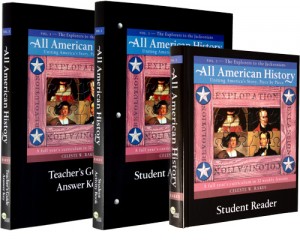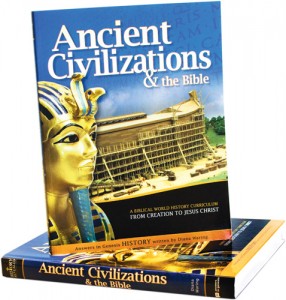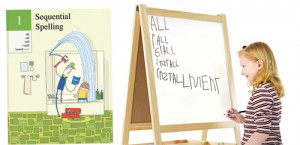Every Curriculum Seller Has a Wonderful Plan for Your Life
As summer draws to an end I am amazed with the inundation of emails I receive advertising curriculum kits; each of which claims that their package will solve all your problems and leave you with a magical, happy school year. Your children will skip out of their room every day and beg to do their school work. You will never be confused about what to teach next. Messes will clean themselves up, and the dog will probably learn to read too! If you believe all the claims you will be sorely disappointed next month when you realize that you are still the same people you were before the new curriculum and still have many of the same struggles.
And Then There’s “That Mom” in Your Homeschool Group
Or, perhaps closer to home, there is that friend who uses ___ and is absolutely convinced that everyone should do the same. This claim is not the kindly recommendation of someone sharing what made all the difference in their family but is instead a demand made with no respect to their friends’ budgets, time frame, personality, or even the needs of their children.
How Do I Sort My Options?
We offer our own curriculum kits and do so because we truly believe they help families in a unique way. Yet no curriculum kit is perfect for every family. So is there a simple, practical way to navigate the options, keeping in mind your family’s unique needs? We think so. Here is a simple checklist to use in comparing your options. Try it and see if it doesn’t make “The One” pop out of the sea of curriculum options!
- How does this curriculum align with my beliefs?
- Does this meet my educational goals?
- Is it within my budget?
- Does this fit my student’s learning style?
- Is it designed for independent learning?
- How does it fit with my daily schedule?
- Is the manual easy for me to use?
- What do reviews say?
- Does it emphasize rote memorization or comprehension?
- How easy is it to reuse with a younger student?
- How does it compare to what I’ve used before?
- Does it work well as a whole-family curriculum?

1} How does this curriculum align with my beliefs?
Think beyond Creation vs. Evolution, and ask how the essentials align with your family’s beliefs. A handful of things you’ll want to discuss with your child is much different than spending as much time unteaching the lessons as you spend teaching them.
2} Does this meet my educational goals?
It is worth pondering what your real goal is for your child this year. Learning to read, cultivating curiosity, passing the state test or learning to work independently are all valid answers. In our family education was geared around life-learning. Thinking skills, reading, math and writing were always our biggest priorities since they are so essential. Science, history, geography, art and foreign languages were icing on the cake: wonderfully fun and productive, but not on our schedule every day. You may find that you want to emphasize something else, such as literature, academically advanced curriculum or to primarily immerse yourself in history.
3} Is it within my budget?
Many families are on a tight budget, this year more than ever, and you’ll need to be reasonable about what you buy. Think it through, pray about it, discuss it, and then get ruthless with your options. (BTW, average private school tuition for an elementary grade was $20,617 in 2011-2012! Makes every option I’ve seen look downright cheap in comparison.) Some families also opt to work with a charter school in order to expand their budget. It is a controversial choice, since you are opting to allow the government to oversee your homeschooling, but we have seen it work well for many of our customers in this tough economy.
4} Does this fit my student’s learning style?
A visual learner will do well with almost every program I’ve seen.
An auditory learner who is given permission to read his lessons aloud will find most curriculum choices manageable, but will thrive with audio books, computer lessons, and discussion-based learning.
The kinesthetic learner is the hardest child to shop for. Many of these bouncy learners are boys, though there are plenty of kinesthetic girls too. Their curriculum needs to include as much hands-on, exploratory learning as possible. When book work is required, it will help to use real-life problems, short lessons, and a non-distracting fidget “toy” for them to fiddle with.
5} Is it designed for independent learning?
Some moms want to hold their child’s hand in every single step of their education. Others, like my Mom, would rather teach us how to learn and watch us take off. Of course the early years are always mom-intense but once your child’s reading skills blossom you will be amazed at how much they can accomplish on their own, if that’s your goal. Some curriculum kits do depend on you to read and oversee lessons for hours a day at every grade level. Make sure this is what you want before you buy!
6} How does it fit with my daily schedule?
Just because your school district usually has children in class, on a bus, or doing homework for 8 or more hours a day is no reason you need to. If your family is juggling a newborn, rowdy toddlers, a child with special needs, the family business, or a special ministry opportunity; if you’re planning a move, planting a giant garden or any of myriads of worthwhile time commitments then look reasonably at your schedule and see what would work best for you. Our family used 1-3 hours a day as a rule of thumb for the early grades, often broken into much smaller chunks throughout the day. This will vary depending on the child and their age. An older child will reasonably take longer since they have more to accomplish. A younger child will do best if their learning is broken up into shorter chunks throughout the day. (We’ve also heard from some of you who are in an apartment and finding a productive use for the hours is tricky. In your case programs that require long hours would be more of a blessing than a burden!)
7} Is the manual easy for me to use?
Don’t confuse this question with asking if the manual is beautiful, immense, or worked well for your friend. The question is will it really work for YOU, or not?
8} What do reviews say?
There are few things more insightful than reading the perspectives of others who have used the program. They are putting the curriculum to work in a real homeschooling family, and while you may not agree with their perspective, it will be invaluable in discerning what will work well for your child. In fact you may find that the reason another family despised it (too much Bible, or not enough writing) are exactly the reasons it will work well for your family.
9} Does it emphasize rote memorization or comprehension?
I can’t think of anyone who would say they only want their child to memorize without understanding. Yet if the curriculum teaches memorization of multiplication facts without teaching why and how we multiply, sight reading without phonics, or historical times without context, then your child may simply skip over understanding, busily memorizing what he needs to know to fill out this week’s worksheet. In the years to come both of you will be distraught to find he forgot all that he never understood, and has to go back and relearn introductory level information in order to continue his education.
10} How easy is it to reuse with a younger student?
If you are blessed with multiple children it will be helpful to know in advance if you’ll be able to use the curriculum again with younger siblings.
11} How does it compare to what I’ve used before?
If you and your student loved last year’s curriculum why are you changing? Or if you hated it, is this really much different? Does it keep the best parts of last year and discard the worst? If this is your first year homeschooling consider what you dislike most about public school. Does this curriculum use the same approach or does it really break that mold to teach in the way that best suits your family?
12} Does it work well as a whole-family curriculum?
It is more fun and much easier for you if you can combine at least a few subjects to study as a family. We liked to combine history, science, art, geography foreign language and electives in our family. Naturally this will vary depending on the ages of your children – I don’t know of a single science program that would work as well for a 1st and an 11th grader together – yet they could both study anatomy at different levels and still enjoy the camaraderie and shared interest of doing so.

And just for fun, here is how Timberdoodle’s Curriculum Kits line up, just to get you started!
1} How does Timberdoodle’s curriculum align with my beliefs?
Only you know your beliefs but I can tell you that our family is a rather conservative Christian family, and we won’t include products that we ourselves wouldn’t use. Yes, there is an occasional page we’d skip (noted in the guides) but these are all items that we are honored to include as part of our curriculum. (If you are ordering with a school district and cannot include Christian materials you’ll be delighted to know that we’ve also made non-religious kits available for 0-8th grade.)
2} Does Timberdoodle’s curriculum meet my educational goals?
This of course depends on your goals. We kept in mind state requirements/standards while developing our course, but our primary goal is to cultivate life-long learners with a particularly strong foundation in the basics of thinking, reading, writing, and math. Beyond that, science and history/geography are thoroughly and engagingly covered, along with introductory art concepts, basic Latin, beginning electronics, economics, and more.
3} Is it within my budget?
Prices range from $299-$595 depending on the grade level.
4} Does this fit my student’s learning style?
Almost every curriculum is easily mastered by a visual learner, and Timberdoodle’s curriculum is no exception. Auditory learners will love the Teaching Textbooks math in grades 3+ and usually find that if they are given permission to read their work aloud, they thrive. Our specialty is really in the hands-on portion of each grade. Make your own history projects, assemble geography puzzles, complete 3D brain-teasers and much, much more! We’ve also included a Thinking Putty in grades 1-12 so that even the bouncy livewire will have what he needs to help him concentrate!
5} Is it designed for independent learning?
Yes, decidedly so. Read more here: Why Timberdoodle Encourages Independent Learning
6} How does it fit with my daily schedule?
We figure 1-3 hours a day for the elementary grades. Younger students will almost never sit down and do all the work at once, instead we suggest doing it in multiple short sessions throughout the day. Read more on our approach here: How Do You Schedule Homeschooling?
7} Is the manual easy for me to use?
We think so, but the real question is how it will work for you, so pop on over to here and you can see for yourself. We include a weekly schedule for you so that you know exactly how many pages/chapters/lessons to complete every week but don’t have the stress of having to do precisely __ on Monday.
8} What do reviews say?
We have received very high reviews. Check them out on our website.
9} Does it emphasize rote memorization or comprehension?
We are all about comprehension and believe that if you really understand something you’ll be able to use it, and if you can use it, you can remember it.
10} How easy is it to reuse with a younger student?
We offer refill packs for each grade, making it easy to purchase only the workbooks and kits you need to use it again next year.
11} How does it compare to what I’ve used before?
That is a question only you can answer. I can give you a broad-brush idea of how it compares to Sonlight, but beyond that we wait to hear from you!
12} Does it work well as a whole-family curriculum?
We prefer that families do science, history, spelling, and sometimes geography together. However, you may have noticed that there is no easy way to implement this online. Every method we considered for doing so would have been so confusing to read through, that we have instead opted to hand-customize each kit for your family’s needs. This is of course free, and all you need to do is drop us a line here and let us know what grades you are combining. We will get back to you with any questions we might have (World or USA history? Which science did you want to use this year?) and then send you a quote with a price and list of all items included. When you decide you are ready to order, just give us a call with your payment information and the quote number and we’ll process it immediately and ship your custom curriculum right out to you.
Other Links You May Find Helpful





















 Twitter
Twitter Facebook
Facebook Youtube
Youtube RSS
RSS GooglePlus
GooglePlus